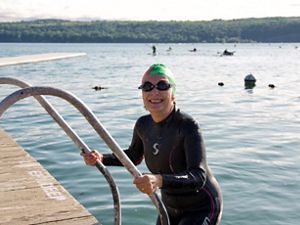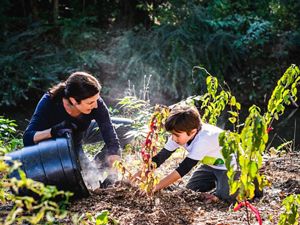Message in a Molecule: How We’re Using Environmental DNA to Protect Aquatic Species
Advanced tools help our scientists detect native and invasive species in Lake Ontario and the St. Lawrence River.
It is a deceptively low-tech move for a high-tech operation. The Nature Conservancy’s New York Aquatic Restoration and Resiliency Coordinator Brittney Rogers, in snow boots and a parka, stands near the marshy end of the Salmon River in Pulaski, New York, and dips a one-liter sampling bottle attached to a pole into a tributary of eastern Lake Ontario. She pulls it in toward her, seals the top, and later that afternoon draws the water through a filter. Beside her, the Conservancy’s New York Sustainable Fisheries Ecologist Philippa Kohn and their seasonal technician Jacob Wojcik maneuver the controls on an underwater remote operated vehicle (ROV), complete with cameras, lights and propellers. “It helps us visualize and characterize the areas where we’re sampling,” Kohn explains.
The trio are deploying these advanced tools—not just the underwater ROV but sophisticated laboratory testing to detect the existence of species’ DNA, called “environmental DNA,” or “eDNA” for short, from the water samples. Next year, the team hopes to construct a mobile lab that will enable them to do all this analysis on-site, to test for the presence of native and invasive aquatic species in 15 tributaries, located between the towns of Oswego to Massena, that feed into Lake Ontario and the adjoining St. Lawrence River.

Environmental DNA (eDNA)
The ability to test species' DNA from environmental samples (in this case, water).
Recovering Native Aquatic Food Webs
These scientists are trying to solve a mystery: Where can they find lake whitefish and cisco? The two fish have played a central role in sustaining life in this part of the world for millennia. But over the last century, their populations have dropped dramatically. Collaborating with academic and government partners, and with funding from the Pittsburgh-based Arconic Foundation, the Conservancy team is also on the lookout for a host of invasive species. These include rusty crayfish, Asian carp and northern snakehead, to name a few. They threaten ecosystems already stressed by overfishing, industrial pollution, and now, most acutely, by climate change. (Here is just one example: Certain fish will only spawn in a limited range of water temperatures. As global warming causes temperatures within the Great Lakes to rise, these fishes’ spawning opportunities diminish.) “This work,” says Rogers, “is an important step toward our goal of restoring native species and preventing further disruptions from invasive species in these bodies of water”— bodies of water that help comprise the Great Lakes, the largest freshwater system on Earth.
Quote: Brittney Rogers
Today, even as these waterways warm, there are hints that the native fish may be returning to their original homes.

It is hard to overstate just how important a role lake whitefish and cisco have played in the food web and the economy of this water-rich region. From perhaps as early as 5,000 years ago, the archeological record shows, aboriginal people here dined on lake whitefish. By 800 CE, many Indigenous Peoples located their settlements close to lake whitefish’s breeding grounds. So plentiful was this fish that European settlers gushed over its abundance and splendor. “One could eat it for days and never grow tired of it,” one explorer wrote. By the 1870s, as Europeans and others colonized the area, commercial fishermen brought in millions of pounds of lake whitefish and cisco a year, selling it across the Midwest and in New York City. Humans are not the only ones with a fondness for these fish, of course. They have been favorites of apex predators such as lake trout and Atlantic salmon—who, in their role at the top of the waterways’ food chain, help keep their ecosystems healthy by limiting the destructive potential of other species—by eating them.
Then to Now: How eDNA Methods Play a Role in Restoration
By the early 1960s, overfishing and industrial pollution put an end to lake whitefish and cisco’s heyday. In more recent times, invasive species have contributed to their decline, too. “Rusty crayfish,” for instance, says Rogers, “prey on fish eggs. So they’re 100 percent directly impacting the native populations by eating their eggs.”
This damage has harmed not only the fishery but the ecosystem as well. The need of the lake’s and river’s top predators to survive on a diet of invasive species has caused what Kohn calls “sub-lethal and chronic impacts on offspring survival.” Fewer healthy predators means a less healthy ecosystem overall.
Today, even as these waterways warm, there are hints that the native fish may be returning to their original homes. They’ve been documented in tributaries of Lake Michigan. Perhaps Lake Ontario and the St. Lawrence can be next, especially if restoration efforts can be deployed for the native fish and interventions can help stop the spread of the invasive species. The information Kohn and Rogers are gathering is foundational to any efforts to restore what was once a flourishing and resilient freshwater system. Says Kohn, “This could change how we think about the future of our work.”
Explore how we collect eDNA
Take a look at how New York Aquatic Restoration and Resiliency Coordinator Brittney Rogers and seasonal technician Jacob Wojcik collect eDNA samples in the Salmon River in Pulaski, New York. Scroll over and click on each image to learn more.
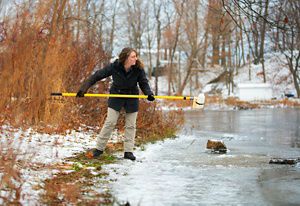
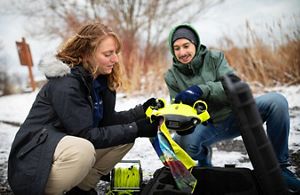
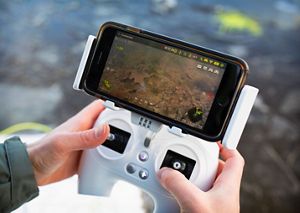
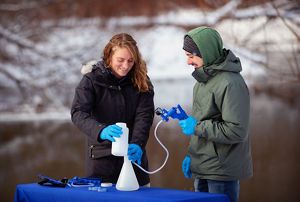
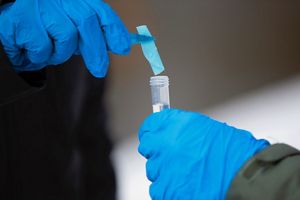

Collecting Samples: New York Aquatic Restoration and Resiliency Coordinator Brittney Rogers collects a water sample from the Salmon River using a sampling pole and 1-liter bottle. © Jason Hunter

A Look Underwater: Rogers and seasonal technician Jacob Wojcik clean their Remote Operated Vehicle (ROV) to prepare for its launch in the water, where it will collect images of habitat. © Jason Hunter

Not Your Average Remote: The ROV’s remote control allows users to interface with the images captured by the machine. The remote’s screen shows a clear view of the river’s substrate. © Jason Hunter

Time to Examine: Rogers and Wojcik examine a sample of water collected at South Sandy Creek. They hand pump and pull the water through filters to collect eDNA. © Jason Hunter

The Final Product: A filter is folded and placed into a vial so that the eDNA it contains can be preserved, transported to a lab for analysis, and used to map the presence of aquatic species. © Jason Hunter

